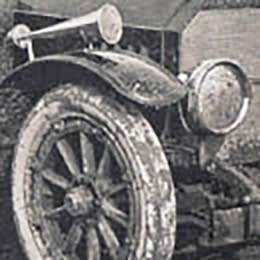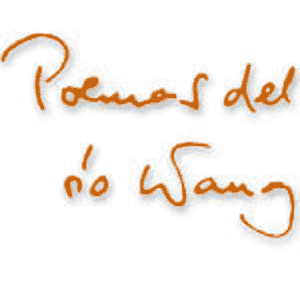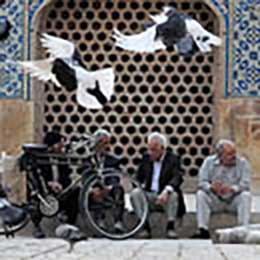
Una sera stavo camminando per la via Celetná nel centro storico. Le luci giallastre dei negozi si riversavano sulla vecchia strada, e diffondeva una vernice dorata sulle cime dei ciottoli, che riecheggiavano il susurro di mille piedi. Era l’ultimo giorno del mese di ottobre, la vigilia di Ognissanti, una serata insolitamente caldo per l’autunno, perfettamente adatta per una lunga passeggiata senza meta. Questo giorno è, secondo la vecchia tradizione, quello dei fantasmi, delle maschere, delle finzioni, un giorno quando le cose non sono ciò che appaiono. L’anglo-celtica Halowe’en ricorda l’antica credenza, che il raccolto annuale è seguito da un tempo liminale, in cui i spiriti dei defunti possono passare con più facilità tra i vivi.
Stavo avvicinando alla Casa Municipale, quando pian piano ho cominciato di sentire qualche melodia acuta, spettrale, ronzio, un po’ difficile da identificare, un suono che poteva venire sia da uno strumento da fiato che da uno ad arco. Il suono misterioso, come l’ho scoperto, veniva dal mezzo di un piccolo cerchio di turisti attorno a una persona che suonava una melodia di Mozart su un This eerie sound, I found, was seeping out from the midst of a small gathering of tourists, at the nucleus of which stood a man performing a tune reminiscent of Mozart on a verrilion, also known as a water glass harp. He held his audience completely in thrall.
i stavo avvicinando la Casa Municipale, quando ho cominciato a sentire una musica acuta, spettrale, ronzio, un po 'difficile da individuare con precisione, con un suono che assomigliava o uno strumento respiro, o una corda. Questo suono misterioso, ho trovato, filtrava dal mezzo di un piccolo raduno di turisti, al nucleo di che si trovava un uomo esecuzione di un brano che ricorda di Mozart su un verrilion, noto anche come un'arpa bicchiere d'acqua. Ha tenuto il suo pubblico completamente in schiavitù.

The verrilionist was standing at a table with a perhaps two dozen wine glasses of various sizes, each containing a quantity of clear water. With unerring technique, he repeatedly dipped the pads of his fingertips into these tiny ponds, and with a practiced stroke pressed on the rim of a glass, a gentle and precise friction that sounded a note by exciting the vessel into ringing vibration. His performance was seamless, with chords, arpeggios, crescendos and glissandos, a wall of ethereal sweetness that, in spite of the perhaps cloying nature of the medium, held a fascination for its morbid, other-worldly quality, which enchants as much as it entertains. It is probably for reasons like this that the instrument has sometimes been called the ghost fiddle. In the 18th century, similar instruments enjoyed a certain vogue, and legends from this time caution us not to indulge in it too much, either in listening or playing, because those who are sensitive to melancholy were thought to be at risk of insanity because of its strange, sad sound.
The supple hands of the ghost fiddler fluttered like little hummingbirds over the glasses’ halos, seeking the sweet essence of the music, and the fairie-like ring of it was a sheer delight. The tourists were recording the performance on mobile phones, paying homage to the performer by tossing coins into a pot laid before him. A lake of sweat grew on the musician’s upper back, soaking through his sweater. He gave the performance every possible nuance of gesture and force. That night, he seemed to be playing in peak form. The audience stood, jaws slack, eyes wide; the eyes of some glistened with tears. There is a reverent hush of awe, as they listened, rapt.
It was a little after ten o’clock when I retreated back down Celetná, toward Old Town Square. I approached the spot where, for nearly 300 years, stood the Marian Column, until 1918, when it was pulled down by a mob, who saw it as a symbol of Austrian oppression. The location of the former column is now marked on the pavement by memorial slabs of granite with epitaphic inscriptions in four languages that read, “Here stood and will stand again the Mary’s Statue.”
Years ago, on my first visit to this spot, I had noticed that, curiously, some later vandal had chipped away selected words from each of the inscriptions in an effort to neutralize the affirmation that the column will stand again. It is clear that the site still evokes strong feelings, and some apparently wish that the monument never again stand, opposing the aspirational inscriptions that explicitly call for its rebuilding.

But on this evening, as I approached the spot, I was a bit startled to see a young nun in a traditional black habit, holding in her arms a bouquet of white lilies, a symbol of resurrection. Her head was bowed solemnly in prayer. As she was about to kneel and lay the bouquet on the memorial where the column once stood, I took out my camera and quickly made an image, taking no time to adjust the settings. I intended to make a series of better exposures, but it was too late. The nun had already noticed the presence of a photographer. I could see the surprise and alarm on her face. Before I could take another picture, she dashed off, cradling the the lilies in her arms as if protecting an infant from the rain, and disappeared into the crowd.

Ghost fiddler Robert Tiso playing Smetana’s Vltava
Another, less epic, but just as sympathetic ghost fiddler playing the same right above Vltava, on Charles Bridge


























Add comment